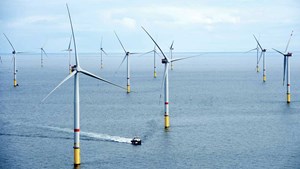Oil majors outbid green energy firms to build offshore UK windfarms
(Bloomberg) --Oil majors agreed to pay a hefty premium to develop the next generation of major British offshore wind farms after BP Plc and Total SE won contracts in an auction ahead of many of the utilities that have dominated the space until now.
The Crown Estate auctioned seabed rights that will allow about 8 gigawatts of new wind farms, enough to power more than 7 million homes. With oil majors taking a majority of the sites, it’s a sign that green energy companies are facing a new era of competition for some of the world’s biggest renewable energy projects.
The winning companies will pay about $1.2 billion per year in total for up to a decade to develop the wind farms. BP led the bidding with an offer about 80% higher than the average of its competitors in the auction for sites in the waters around England and Wales, an area it’s long familiar with through its oil operations.
“These huge upfront costs will put up barriers to entry for utilities and oil and gas companies without very deep pockets,” Barclays Plc analysts led by Dominic Nash said in a note.
Big Wind
It’s the first time in a decade the Crown Estate has offered seabed for new wind farms and the first time it’s done so with this kind of competitive auction. The industry has changed drastically in the meantime as the cost of construction and financing plummeted and competition for the projects has soared, most notably from traditional fossil-fuel producers.
Winning bids came from a consortium of BP and German utility EnBW Energie Baden-Wuerttemberg AG for a total capacity of 3 gigawatts, while a partnership of Total and Macquarie Group Ltd.’s Green Investment Group got 1.5 gigawatts and RWE AG’s renewables arm won 3 gigawatts. Cobra Instalaciones y Servicios SA and Flotation Energy Plc, a floating wind farm specialist, will jointly develop a 480-megawatt site.
Getting hold of the seabed rights is the crucial first step in building a wind farm, a process that can take years.
Renewable Power
The development rights will also be key for BP and Total to realize the oil companies’ goals to dramatically scale up their renewable power businesses.
BP made its first foray into offshore wind last September when it agreed to pay Norway’s Equinor ASA $1.1 billion for a project in the U.S. The oil major is in the process of what Chief Executive Officer Bernard Looney calls “greening” as it aims to slash carbon emissions and ramp up spending in renewables over the coming decades.
The victory in the U.K. waters certainly comes at a steep price. BP and EnBW agreed to pay 154,000 pounds ($211,000) a megawatt per year for the right to build on sites in the Irish Sea, or almost half a billion pounds annually during the development phase. Once the project starts generating power, the payment will shift to a percentage of the revenue.
“We love these leases as they’re close to shore and right next to each other, so we can use the same equipment,” Looney said Monday in a post on Instagram. “While we may be new to offshore wind, we’re not new to offshore. We have spent more than 50 years working on complex, demanding projects out at sea.”
Looney expects the project to be operational within seven years. Despite paying the most for the seabed sites, it will still have to compete with companies that paid less for rights to sell power at guaranteed prices. Still, BP expects returns of about 8% to 10% with the wind farm integrated into its trading unit.
But in order to get that rate of return, which is lower than those from oil and gas projects, “everything needs to go right,” says Luke Parker, Vice President of Corporate Research at Wood Mackenzie. The assets themselves will cover costs.
“Over and above that you’re looking at the integration, the operational advantages they might bring, the farm-downs, power trading and technology advances in renewables,” he said. “They need all of that to happen just to get to that 8-10% and it’s unproven.”
The auction results will be a major loss for incumbent players such as Orsted AS, Iberdrola SA, Equinor ASA and SSE Plc that have previously dominated the offshore wind sector in the U.K.
Orsted, the world’s biggest developer of offshore wind farms, fell more than 2% Monday. BP shares gained about 1.9%.
Excessive Cost
“Excessive costs for seabed risks driving unsustainable financial returns for developers and passing higher energy costs on to future energy consumers,” said Martin Neubert, Orsted’s chief commercial officer and deputy CEO.
The next generation of projects will be vital to Prime Minister Boris Johnson’s goal to quadruple the country’s offshore wind capacity in the coming decade, a central plank of his plan to cut carbon emissions. With such high fees for the seabed rights, it’s not clear if the falling cost of wind farms will continue.
“The result of this leasing round shows that while demand for new offshore wind projects has never been higher, too few sites were made available to meet this demand,” said Melanie Onn, deputy chief executive officer of industry group RenewableUK. “Any auction run on that basis will inevitably lead to high fees like these, and our concern is that this could ultimately mean higher costs for developers and consumers.”
The Crown Estate, the manager of the waters around England, Wales and Northern Ireland, hasn’t yet said when it will auction more areas.
The property in the Crown Estate portfolio is owned by the monarchy and managed in the public interest along with Queen Elizabeth II’s private assets. Profits are sent to the Treasury, but the Queen’s household receives a part of that.




